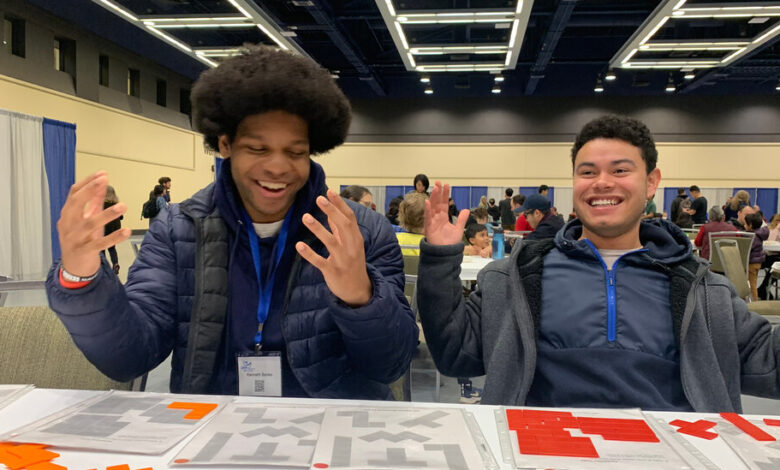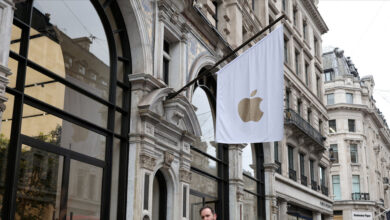In Seattle, a meeting of 5,444 mathematical brains

The world’s largest gathering of mathematicians was convened in Seattle from 8 January to 11 January – 5,444 mathematicians, 3,272 talks. This year the program changed to some extent with its traditional polymorphic Panorama. An official theme, “The Edge of AI in Mathematics”, was determined by Bryna Carr, President of the American Mathematical Society, hosting the program in collaboration with 16 partner organizations. In a configuration or any other, the meeting, joint mathematics meetings, or called JMM, is held more or more annually for more than a century.
Dr. Kra intended the AI theme as a “Wake-up call”. “AI is something that is in our life, and the time to start thinking is how it affects your teaching, your students, your research,” he said in an interview with the New York Times. “What does AI mean as co-author? These are the types of questions that we have to struggle. ,
On the second evening, Meta’s Chief AI scientist Yan Laken gave a main lecture, titled “Mathematical Obstacles in the way of human-level AI” Dr. Lakeun found a little in technical weeds, but had digestible clockbits.
“The current status of machine learning is that it is useless,” he said during the lecture, for much more chortling. “Never mind a human being, never try to reproduce mathematicians or scientists; We cannot even do what a cat can do. ,
Instead of the generative big language model that powering chatbots, he argued, a “large scale” World model“There will be a better condition for advancing and improving technology. Such a system, he said in an interview after a lecture, “can make and plan because it has a mental model in the world that predicts the consequences of its action.” But there are obstacles, he admitted – some mathematically unwavering problems, their solutions are not in sight anywhere.
Diradre Haskel, director of Fields Institute for Research at Mathematical Sciences in Toronto and a mathematician at McMaster University, said that he said that he Dr. Lakeun’s reminder appreciated, as he recalled, “The way we use the word AI today is only one way. Probably a ‘artificial intelligence.’
Dr. Lakeun mentioned in his lecture that the artificial general intelligence word, or a machine with AGI-Manav-tier intelligence-was a false name. Humans have “general intelligence at all,” he said. “We are very special.” Favorite words in Meta, he said, “Advanced machine intelligence,” or Amy – “We pronounce it ‘Amy’, which means a friend in French.”
Dr. Haskel was already sold on the importance of “AI to use AI to use AI, and the huge problem of understanding AI’s mathematics”, an expert in mathematical argument, he to create an equivalent of a textbook Planning to use a theorem-dominated program: a collection of results that can be used by the AI system to generate more complex mathematical research and evidence and verify.
For Kenny Banks, a graduate at the University of Northern Carolina in Greensboro, who attended JMM, does not appeal as a tool for artificial intelligence exploration. He said, “I think the mathematics that people love is inspired by human curiosity, and the computer that finds interesting cannot be the same as man seems interesting,” he said in an email . Nevertheless, they did not regret that they squeeze any AI-related dialogue in their journey program. “Math + AI theme was definitely of interest, it was not just working with everything I planned!”
There are some other highlights from Mathapaluza in Seattle:
day 1
Contents [hide]
After 6 pm on Wednesday, January 8, after a ribbon-cutting and award ceremony, the attendees approved a grand-inauguration reception in an exhibition hall. Draw was a) free food, and B) the exhibitors are occupied by booth publishers and purveers of various fenugreek goods. In Booth 337, Robert Fatehir was selling an impressive list of dice – which includes the new “included”Get 5-Khiladi first dice“A colored set of five 60-sided dice that does not normally share any number, allows five game players a uniform shot when they roll to determine who starts first. Who starts first. Dr. . Fathore, located in Arizona, was also the co-organizer of the art exhibition and contributed to his own two ceramic sculptures, “hyperbolic helicoid” and “cubic squeeze”.
The exhibition was the award -winning Art submission “Sandal Monster”, by Greenwich in Wool, Copper and Nylon, by Shing Dong of Con, by a Mathematical artist with a PhD. In physics…
… And “twisted” and “untreated”, were designed using a vector graphics app on an iPad, which was a mathematical artist in Waterloo, Ontario by Rashmi Sundar-Raj.
Rebecca Lynn, a Ph.D. Students in Computer Science in MIT received a respectable mention for a laser-cut engraving titled “disintegration (state of mind)”.
Day 2
On Thursday, John Wilde, a music theorist at McGill University in Montreal, who performs mathematics on the side, was invited for a session on applied mathematics to discuss his investigation in the “Circle Counting Arrangement” in the aircraft. Given some obstacles, there is a way to attract a circle, three ways to draw two circles, three for four, 173 ways, and 16,951 ways to draw five. (Counting of six circles is yet to be calculated.) Dr. Wilde was surprised to learn that this research was relevant to 3-D printing: that is, how many printers can trace each circular arcs while avoiding collisions. “I tickled,” Dr. Wilde said.
During a session on mathematics and art, Susan Goldstein, a mathematician from St. Mary’s College of Maryland, gave lectures about his “Poinekere Blues” craft project. Nominated for French mathematician Henry Pinkere, the project included creating a patchwork denim skirt from old jeans. As he described in a right-up: “After noodling with different patterns, I settled on the tiling of the poinkere disc model of the hyperbolic aircraft by the 30º-45º-90º triangle,” who was familiar with him An example Classical giant by HSM Coxator (and who also inspired Dutch artist MC Estchet).
Third day
In the afternoon, graduate poster session was buzzing with exposure on subjects including lunar time synchronization; Mathematics of piano tuning; Loop in a four-dimensional place; And a model for forest fire, smoke spread and their public health results.
During another session on Mathematics and Art, Barry Sipra, a mathematician from Minnesota, “one thing about”, “”Gelbs Fled“(” Yellow Field “), a painting by Bahaus-Directed Swiss artist Max Bill.
It may appear to be a solid canvas of color, Dr. Sipra said, but opposite dots, or, more accurately, is a unconscious pattern of squares. “Let’s look at an essence version of the essence of the bill,” he said. “Can you tell what is the bill?”
Dr. From Sipra’s analysis, the artist encoded a classic 3-3 magic square in painting-a square array of numbers that create a logic puzzle that has each row, column and diagonal equal to 15.
Another specialty was that there were five pips in each line, column and diagonal (eg on dice or domino):
Dr. Sipra said, “It looks like a bill and solves an original mathematics problem and hides it in a painting: can you keep the pips within each square of 3 -Bai -3 magic square so that Each should be exactly five pips, the main diagonal of the row, column and 9 -by -9 subgroup? It is clear what is going to be the answer. “
Dr. Goldstein gave Dr. Found Sipra’s discovery. ,I am always excited when mathematics changes in a place where you don’t expect it, ”he said in an email. “I often use these stunning connections to get students who are afraid of mathematics to see its beauty or bored.”
Day 4
The last day offered many public events, including a mini. Math ceremony With puzzles and games on hands.
“Why is this mathematics?” 7 -year -old Alexandra of a geometric puzzle asked with Upton.
“Because we can count in all different ways that we keep the shapes together,” her mother, Karolina Sarnovska-Apton, Redmund, said a software engineering manager of Microsoft in Wash.
In a public lecture, Ravi Vaccil, a mathematician and the upcoming president of the American Mathematical Society at Stanford, simultaneously “detected”Doodling math,
In another, a mathematician and pianitist Eagenia Cheng addressed “Mathematics, Art, Social Justice” at a school in Chicago. One of his main messages: “Pure mathematics is an outline to agree on things.” He sang some lectures with a recorded video playing the piano.
And a documentary film, “Create Pathway” had a world premiere, in “” in “” in “”Travel of black mathematicians“Series by director George CSICSERY. (It is aired At public television stations In February.) The film’s senior advisor was Johnny Houston, an Emeritus Professor at Elizabeth City State University in North Carolina. After screening, Dr. Houston commented on the 2025 premiere timeliness: In 1925, Albert Frank Cox became the first African American – and the world’s first black man – to get PhD. In mathematics. Among his own journey, and many black mathematicians, Dr. Houston said that with exposure, experience and opportunity, “We can do with any mathematician in PhD earnings.” and beyond.”
That evening became the last wound of talks. The next morning till 3 o’clock, as some attendees went to the airport, two mathematicians were just going to bed, but not before riding a lift for the hotel lobby to ask for a late checkout.
,
#Seattle #meeting #mathematical #brains



